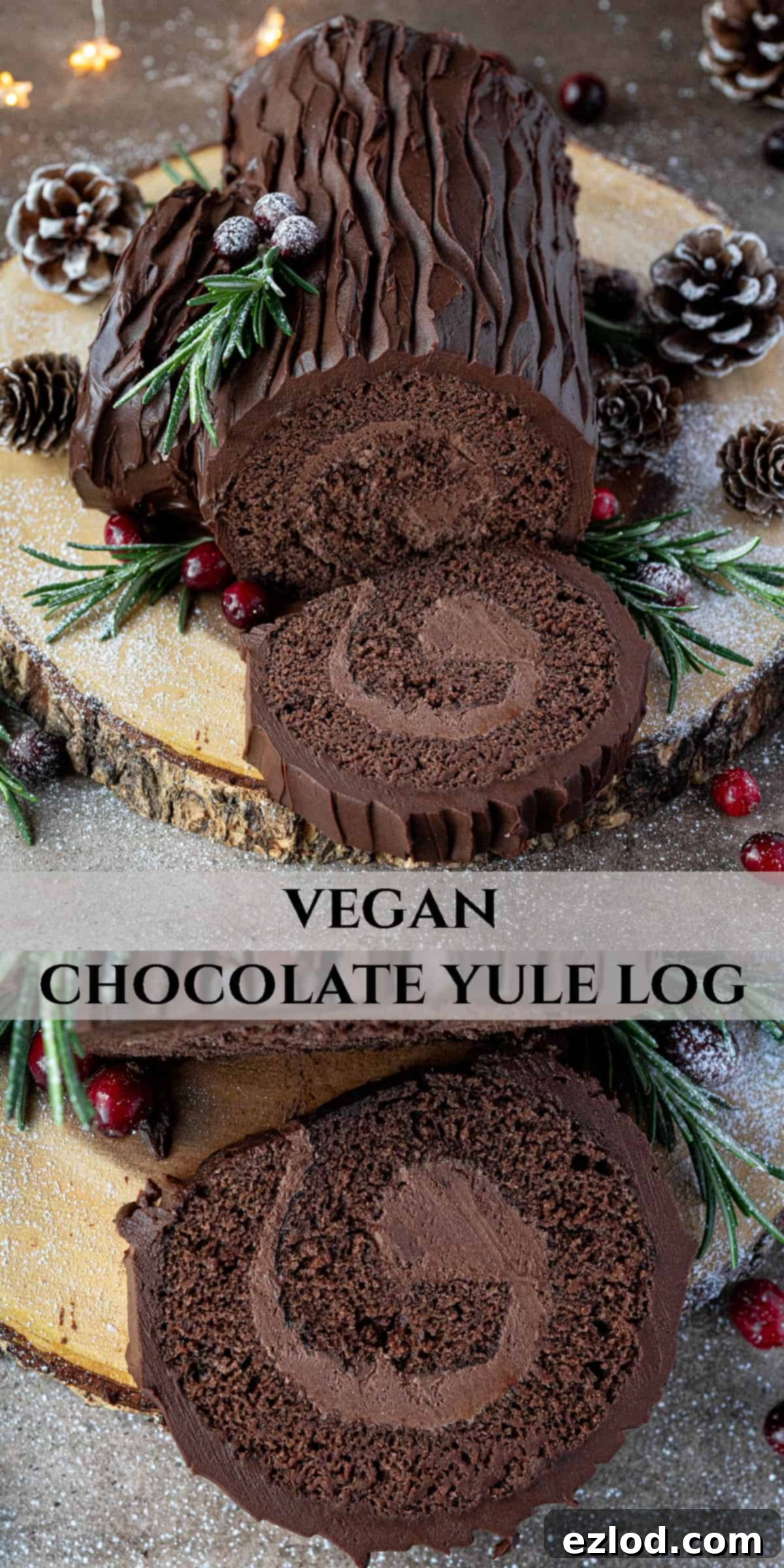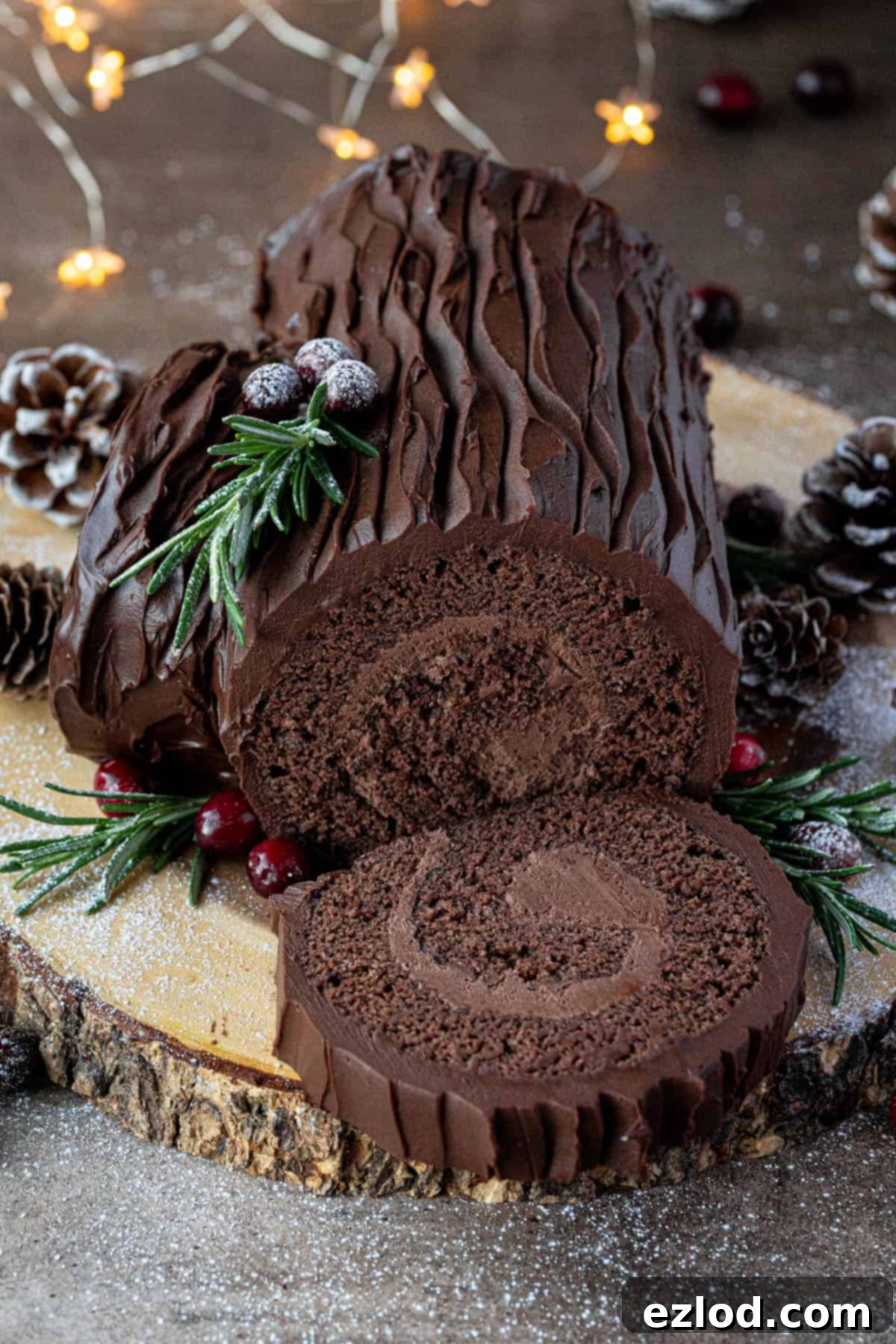Decadent Vegan Chocolate Yule Log: Your Ultimate Festive Showstopper
Prepare to impress your holiday guests with this exquisite vegan chocolate yule log! More than just a dessert, this luxurious plant-based Swiss roll cake is a true Christmas centerpiece, guaranteed to draw gasps of delight. Featuring a tender, moist chocolate sponge, generously filled with a velvety chocolate buttercream, and enveloped in a rich, glossy chocolate ganache, it’s an absolute dream for any chocolate enthusiast.
Crafting a show-stopping dessert for the festive season doesn’t have to mean compromising on ethics or flavor. Our carefully developed vegan Bûche de Noël offers all the indulgence and beauty of the classic, reimagined for a plant-based diet. Each slice reveals a perfectly spiraled delight, making it an irresistible treat that embodies the spirit of Christmas.
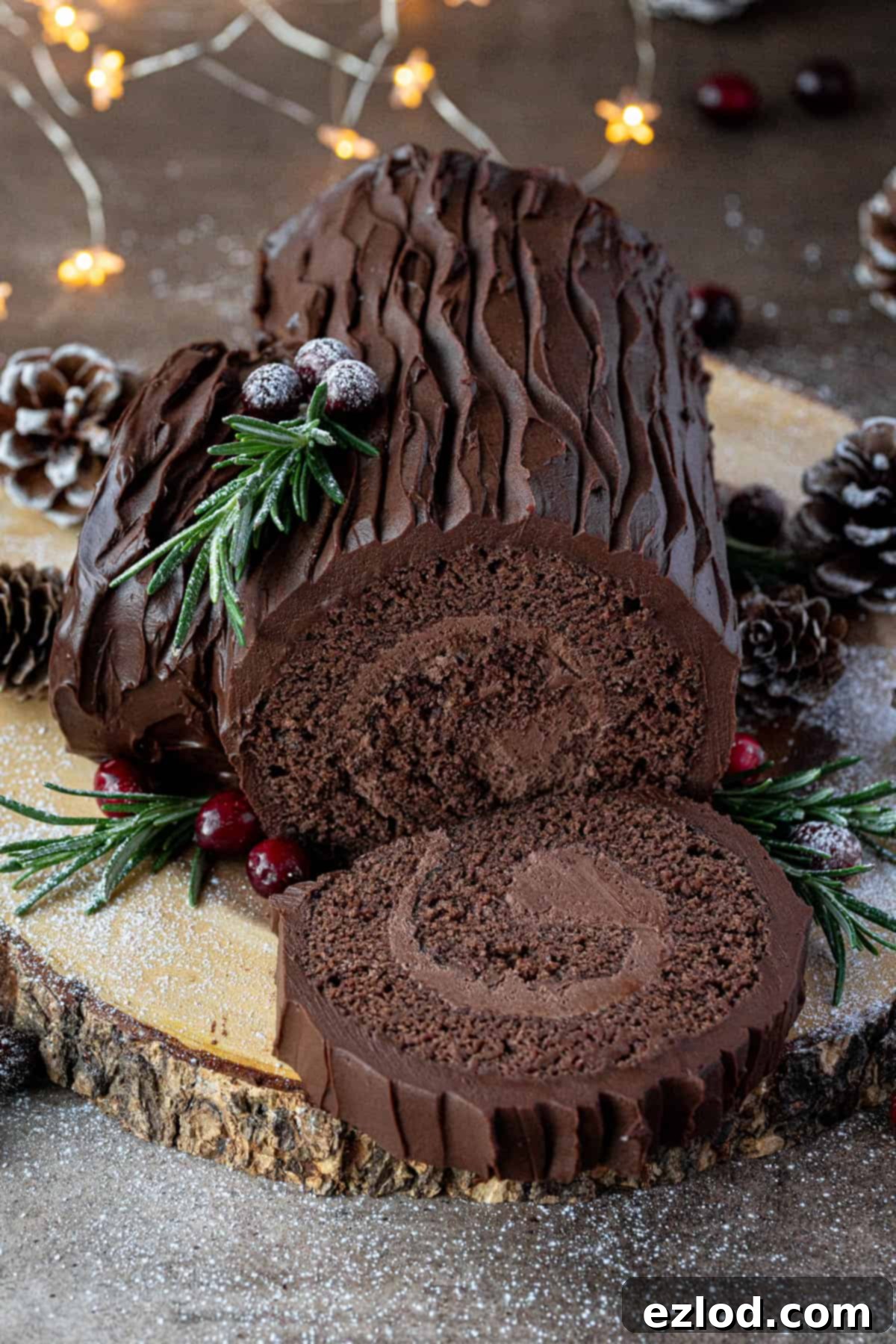
Understanding the Festive Bûche de Noël Tradition
The yule log, or Bûche de Noël as it’s known in French, is a cherished Christmas tradition that originated in France during the 19th century. This iconic dessert, popular throughout Europe and beyond, symbolizes the actual yule log that families would traditionally burn during the Christmas period, bringing warmth and good fortune. Its intricate design, often mimicking a wooden log, makes it a visually stunning addition to any holiday table.
Typically, a Bûche de Noël consists of a light genoise sponge cake, carefully rolled and filled with a creamy center, then coated in chocolate buttercream or ganache and artfully decorated. While the tradition is rich, veganizing such a classic recipe presented a unique set of challenges. Traditional Swiss roll cakes rely heavily on eggs, often using up to six, which are crucial for creating a flexible sponge that can be rolled without cracking. Replicating this elasticity and delicate texture in a plant-based version required extensive testing and meticulous adjustments.
Through countless trials, we’ve perfected a vegan chocolate yule log recipe that achieves remarkable flexibility and flavor. While no rolled cake can be entirely guaranteed against minor cracks – even non-vegan versions can be prone to them – this recipe has consistently yielded beautiful results. Any small imperfections that might occur tend to be on the inside layers of the roll and are easily concealed by the decadent ganache. We’ve also refined the rolling technique: instead of rolling the hot cake in a tea towel, which often increases the risk of cracking, this method involves cooling the cake between two sheets of baking paper. This ingenious trick traps steam, ensuring the cake remains wonderfully moist and pliable, making the final roll-up much smoother and more successful.
The result is a light, airy, genoise-style chocolate sponge, perfectly complemented by a sweet and creamy chocolate buttercream filling, all crowned with a rich, dark chocolate ganache icing. This vegan chocolate yule log is undeniably indulgent, so be prepared to serve it in elegant, thin slices!
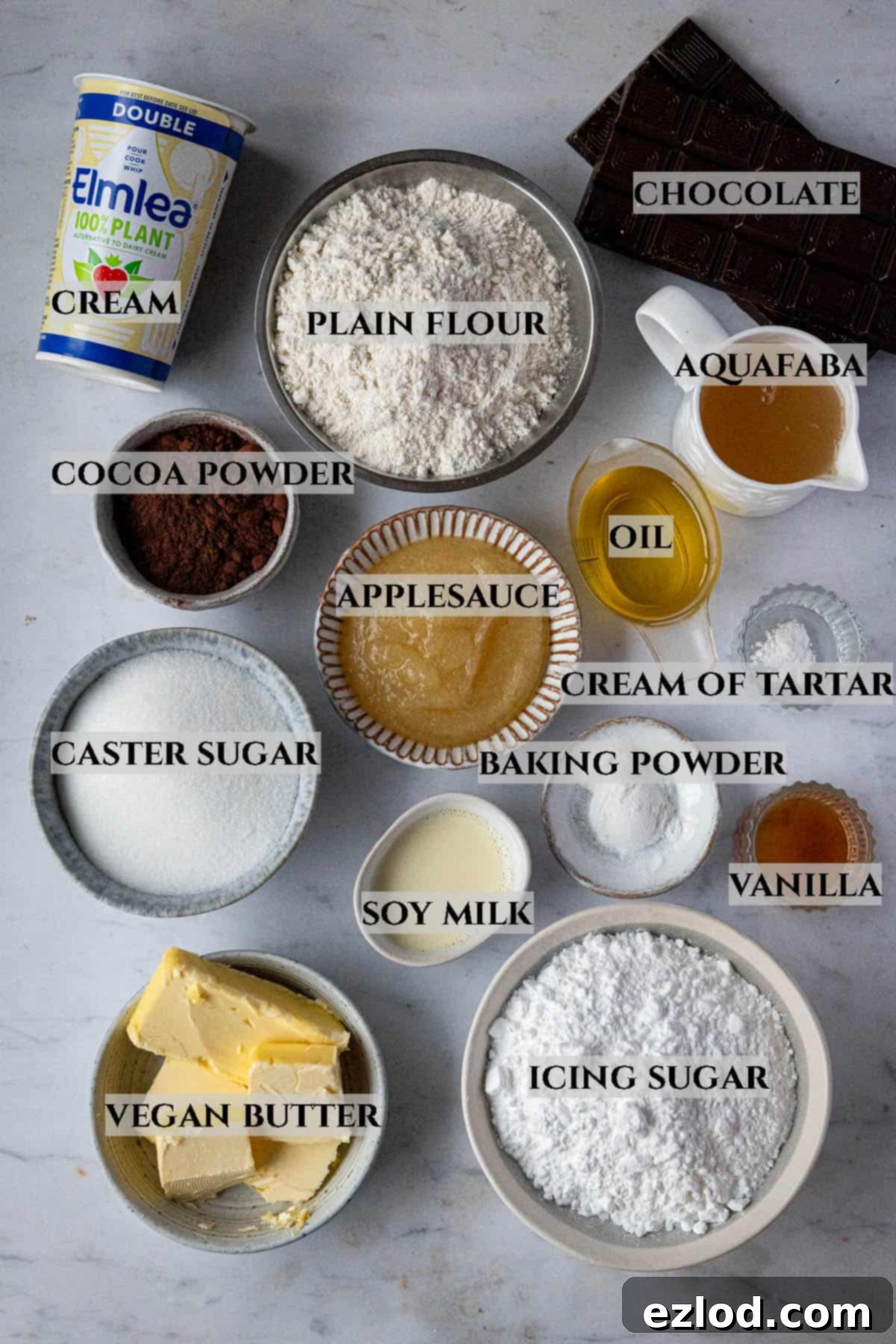
Key Ingredient Insights for Your Vegan Yule Log
Understanding the role of each ingredient is essential for perfecting this delicate vegan Bûche de Noël. Here’s a closer look at the key components:
- Aquafaba: This incredible liquid from canned chickpeas acts as a fantastic vegan egg white substitute. Just like traditional Swiss rolls rely on whipped eggs to create a light and airy sponge, aquafaba is whisked until thick and foamy, giving our vegan cake its delicate structure. Unlike some aquafaba recipes, you won’t need to reduce it to achieve stiff peaks here; a softly whipped cream consistency is perfect. Feel free to use liquid from chickpeas, cannellini, or butter beans, or a store-bought aquafaba product.
- Apple Sauce: This ingredient is vital for adding moisture, stability, and crucial flexibility to the cake, preventing it from cracking during the rolling process. It’s imperative to use smooth apple sauce without any apple chunks. Unsweetened apple sauce is ideal, but if you can only find the kind typically served with pork, simply press it through a fine mesh sieve with the back of a spoon to remove any lumpy bits. Homemade apple sauce is also an excellent option if you have the time.
- Cocoa Powder: For the best results in this recipe, opt for Dutch-processed cocoa powder. This type of cocoa has a neutral pH, which contributes to the deep, dark color and rich, mellow chocolate flavor of the sponge. In countries like the UK, “regular” cocoa powder is typically Dutch-processed. Avoid natural cocoa powder, which is more acidic and behaves differently in baking.
- Cream of Tartar: This acidic salt is a crucial stabilizer for the aquafaba. It helps the aquafaba whip up more easily, achieve better volume, and maintain its structure. If you don’t have cream of tartar on hand, a small drop of lemon juice or vinegar can serve as an effective substitute, providing the acidity needed for stabilization.
- Sugar: Caster sugar (also known as superfine sugar) is highly recommended for this recipe. Its fine crystals dissolve quickly, resulting in a smoother batter and a more tender cake crumb. While granulated sugar can be used in a pinch, avoid substituting with other types of sugar or alternative sweeteners, as they can significantly alter the cake’s texture and moisture balance.
- Vegan Block Butter: When it comes to the buttercream, the choice of vegan butter is critical. You must use a block-style vegan butter, not the spreadable kind that comes in a tub. Spreadable vegan butters have a higher water content and are more prone to splitting, leading to a runny or overly soft buttercream. Brands like Flora Plant Butter or Naturli Vegan Block are excellent choices, offering the firm, creamy texture needed for a stable buttercream.
- Vegan Cream: For the ganache, you have a couple of reliable options. A high-quality vegan double cream alternative, such as Elmlea, will yield a wonderfully rich and smooth ganache. Alternatively, you can create your own ganache base by combining unsweetened non-dairy milk (soy milk is a great choice) with vegan block butter. Both methods will result in a luxurious ganache perfect for coating your yule log.
Essential Equipment for Yule Log Success
To ensure a smooth baking process and a perfect vegan chocolate yule log, having the right tools on hand is important. Here’s what you’ll need:
- Electric Mixer: An electric hand mixer or a stand mixer is absolutely essential for whisking the aquafaba. Attempting this by hand will be an extremely long and strenuous task, and you’ll struggle to achieve the necessary volume and consistency. Invest in a good mixer to make this step effortless.
- Swiss Roll Tin: Also known as a jelly roll pan, this shallow rectangular baking tin is specifically designed for thin cakes that need to be rolled. The ideal size for this recipe is approximately 23 x 33 cm to 25 x 35 cm (roughly 9×13 to 10×14 inches). This size ensures the cake bakes evenly and is thin enough to roll without cracking.
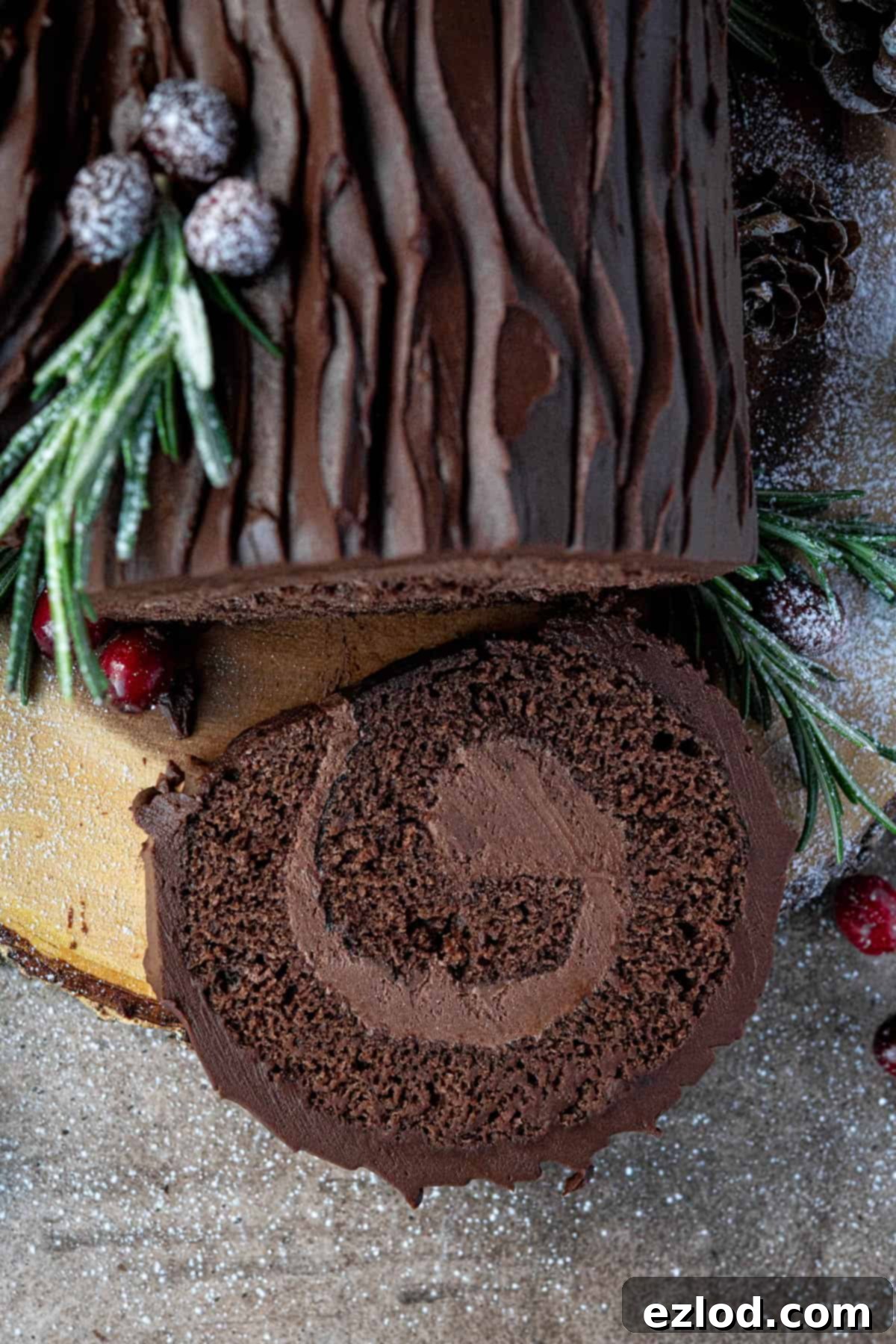
Crafting Your Vegan Chocolate Yule Log: A Step-by-Step Guide
(For precise measurements and full instructions, please refer to the comprehensive recipe card located at the bottom of this page.)
Creating this stunning vegan chocolate yule log is a rewarding process. Follow these detailed steps to ensure your festive dessert turns out perfectly:
Step 1: Begin by preparing the aquafaba. In a spotlessly clean bowl, combine the aquafaba and cream of tartar. Using an electric mixer, whisk until the mixture becomes white and frothy, indicating it’s starting to aerate. Gradually add the caster sugar, one spoonful at a time, whisking thoroughly after each addition. Continue this process until the aquafaba reaches a consistency similar to softly whipped cream. It should appear white and glossy, and the beaters should leave distinct trails in the mixture, though it won’t yet form firm peaks.
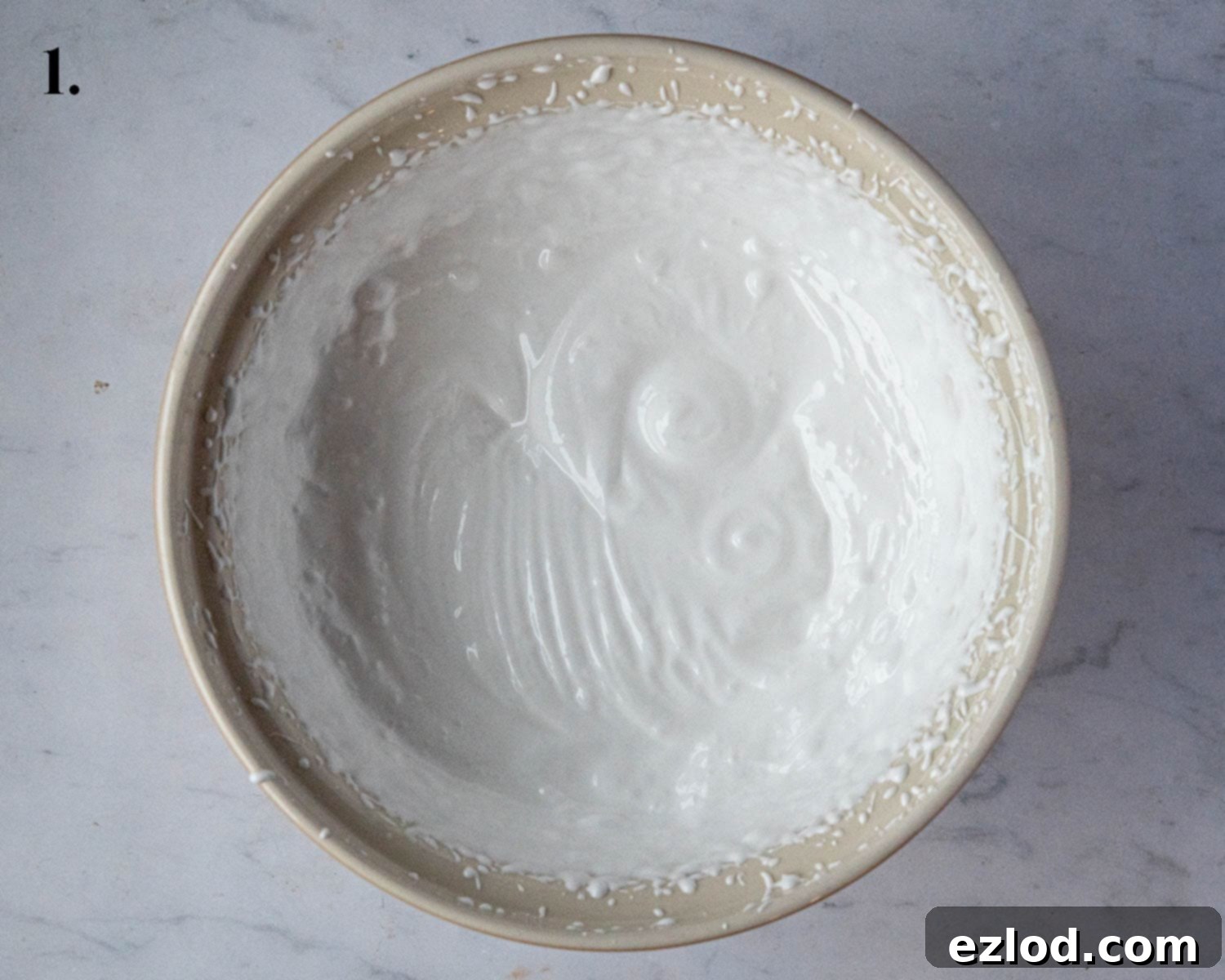
Step 2: Next, prepare your dry ingredients. Sift the flour, cocoa powder, baking powder, and salt together over the whipped aquafaba. Using a spatula, gently fold these dry ingredients into the aquafaba. The goal is to incorporate them until they are about halfway combined, being careful not to deflate the airy mixture too much.
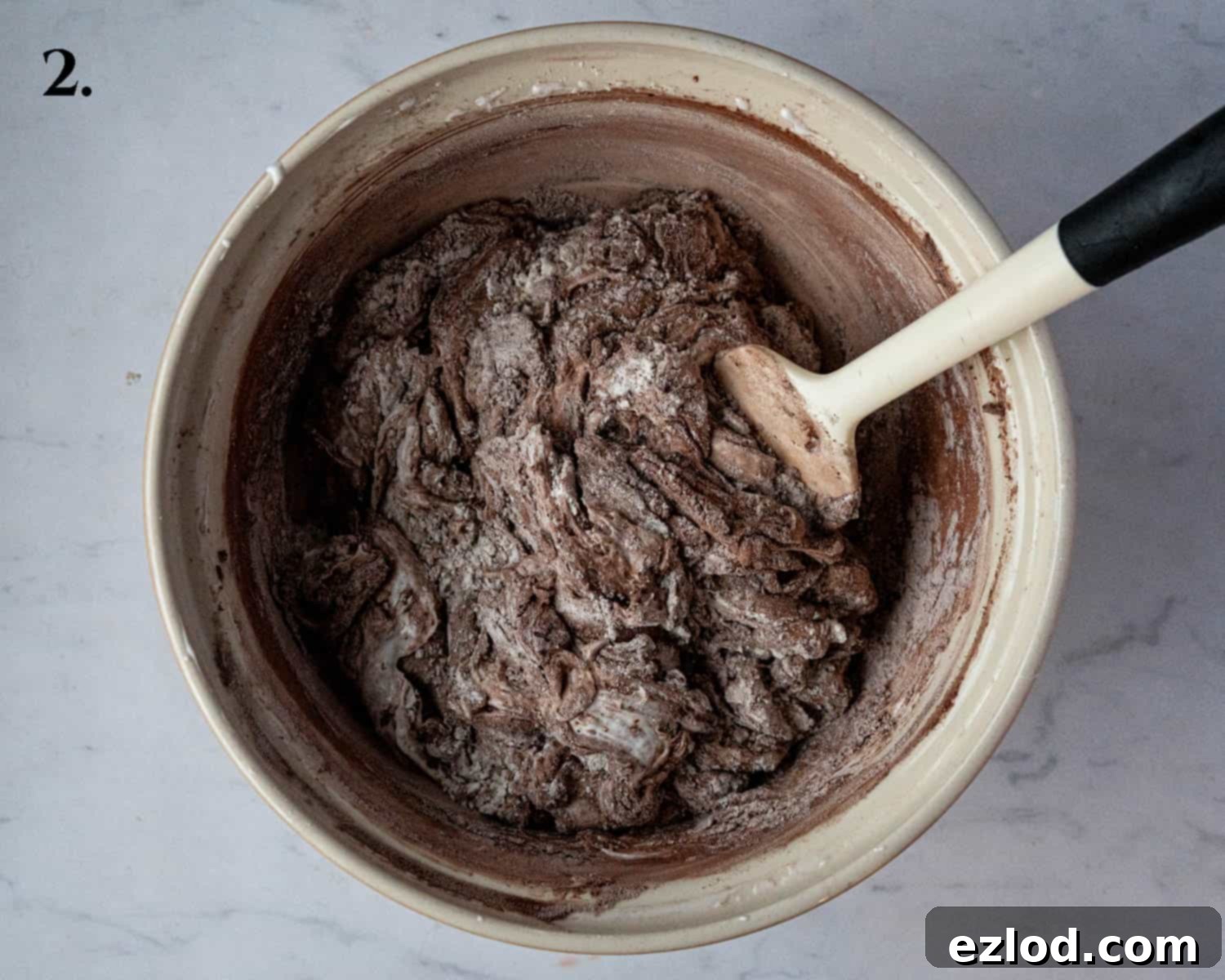
Step 3: Introduce the remaining wet ingredients. Add the smooth applesauce, olive oil (or another neutral oil), non-dairy milk, and vanilla extract to the batter. Continue to fold gently until no dry lumps are visible and the mixture is fully combined. While the batter will naturally deflate somewhat, strive to preserve as much of the incorporated air as possible for a light sponge.
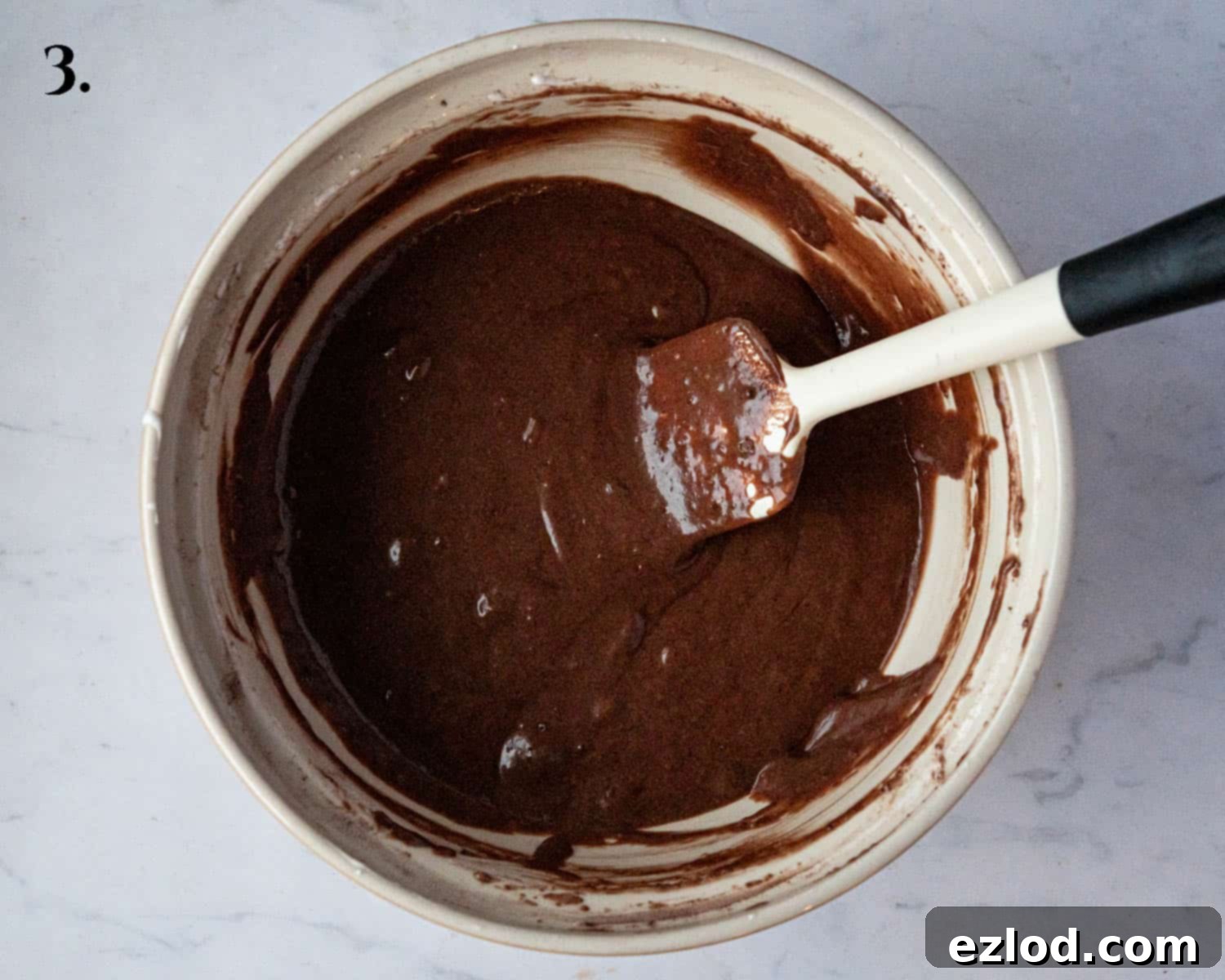
Step 4: Pour the prepared batter evenly into your lined Swiss roll tin. Spread it level with a spatula to ensure uniform thickness, which is key for an even bake and successful rolling. Bake the cake for approximately 8-11 minutes, or until it is set and a skewer inserted into the center comes out completely clean. Be vigilant not to over-bake, as this can dry out the sponge and make it brittle.
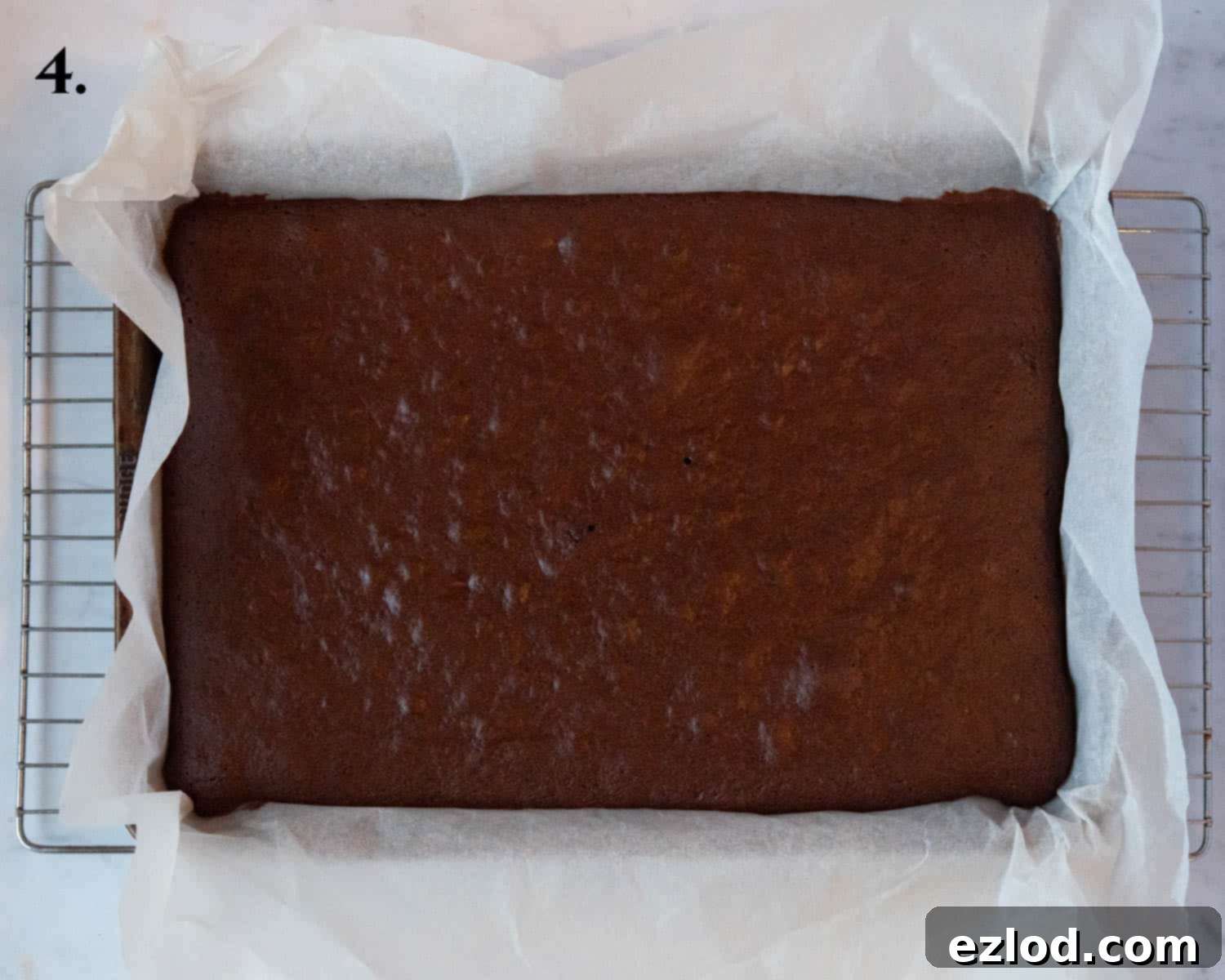
Step 5: Immediately after baking, carefully invert the hot cake onto a sheet of baking paper that you’ve lightly dusted with cocoa powder. This cocoa dusting helps prevent sticking and adds a subtle chocolate flavor to the exterior. Do not remove the parchment paper from the underside of the cake. Allow the cake to cool completely between these two sheets of parchment for about 1 hour. This method traps steam, keeping the cake moist and flexible. While the cake cools, use this time to prepare your rich chocolate buttercream filling.
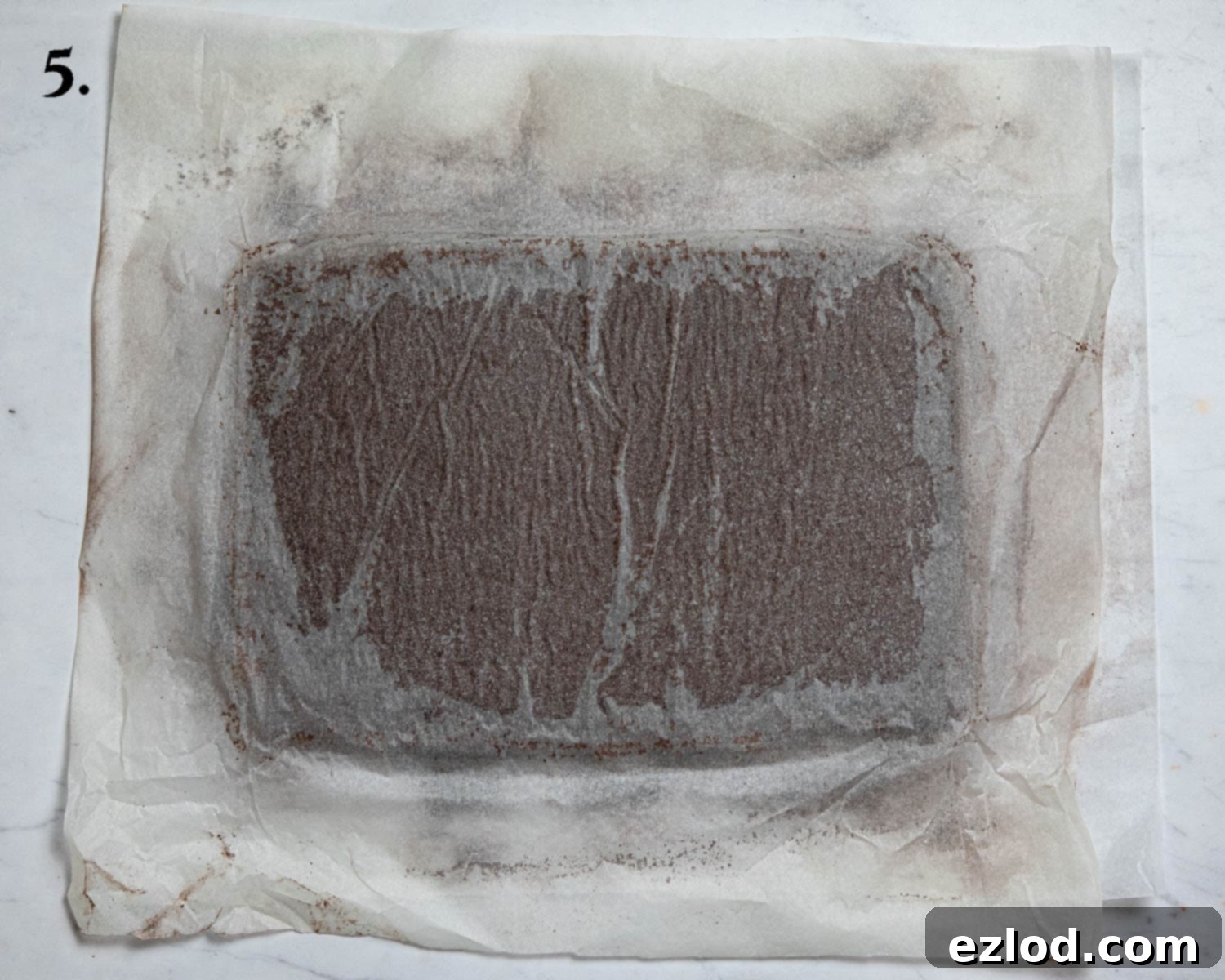
Step 6: Once the cake is fully cooled, gently peel off the top sheet of baking paper. Using a sharp serrated knife, carefully trim off the drier edges of the cake. These edges are typically firmer and more prone to cracking during rolling, so removing them helps ensure a smoother, more successful spiral.
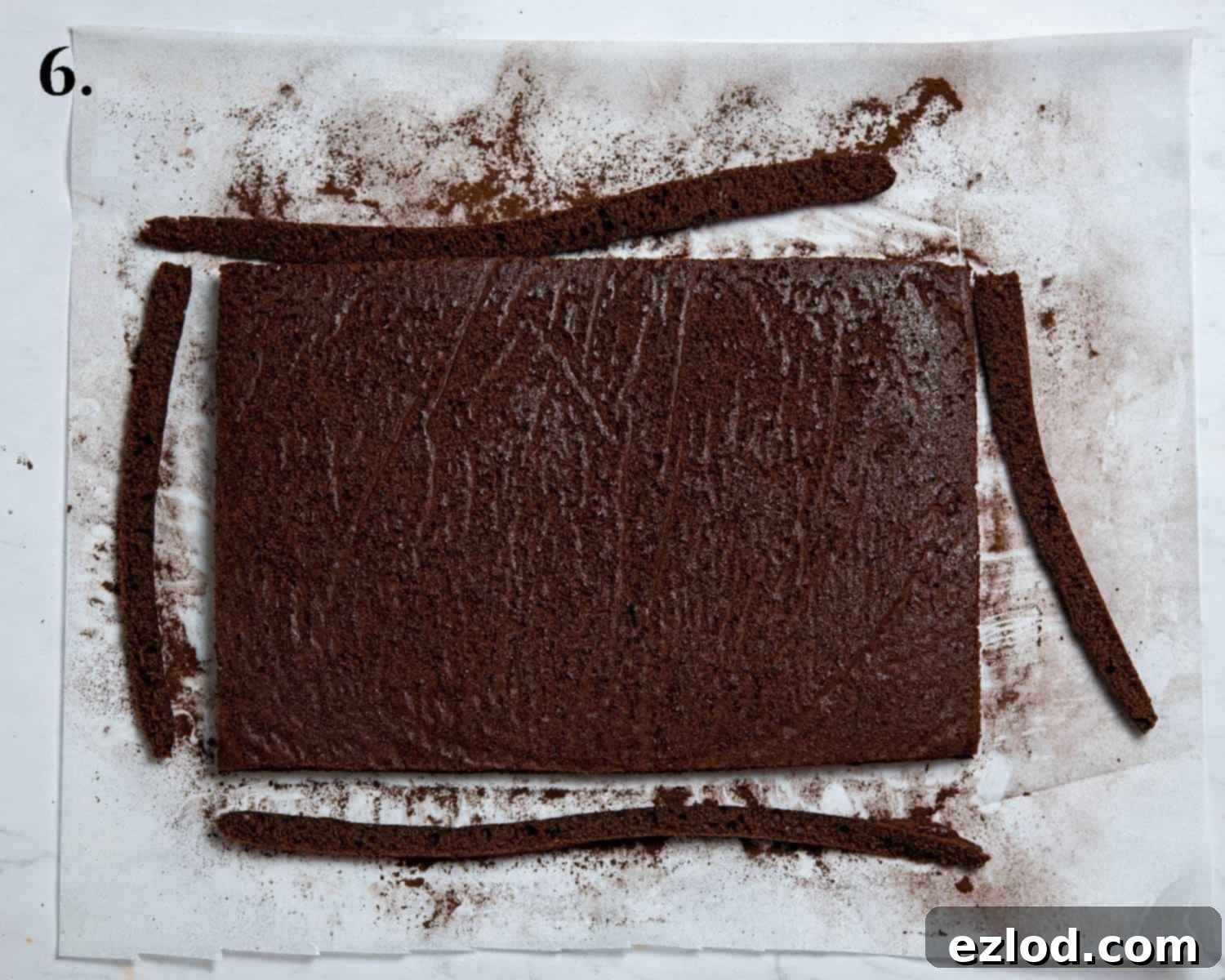
Step 7: With your palette knife, spread the prepared chocolate buttercream evenly over the entire surface of the cake, leaving a small border around the edges. Aim for a consistent layer of buttercream to ensure a balanced flavor in every bite of your yule log.
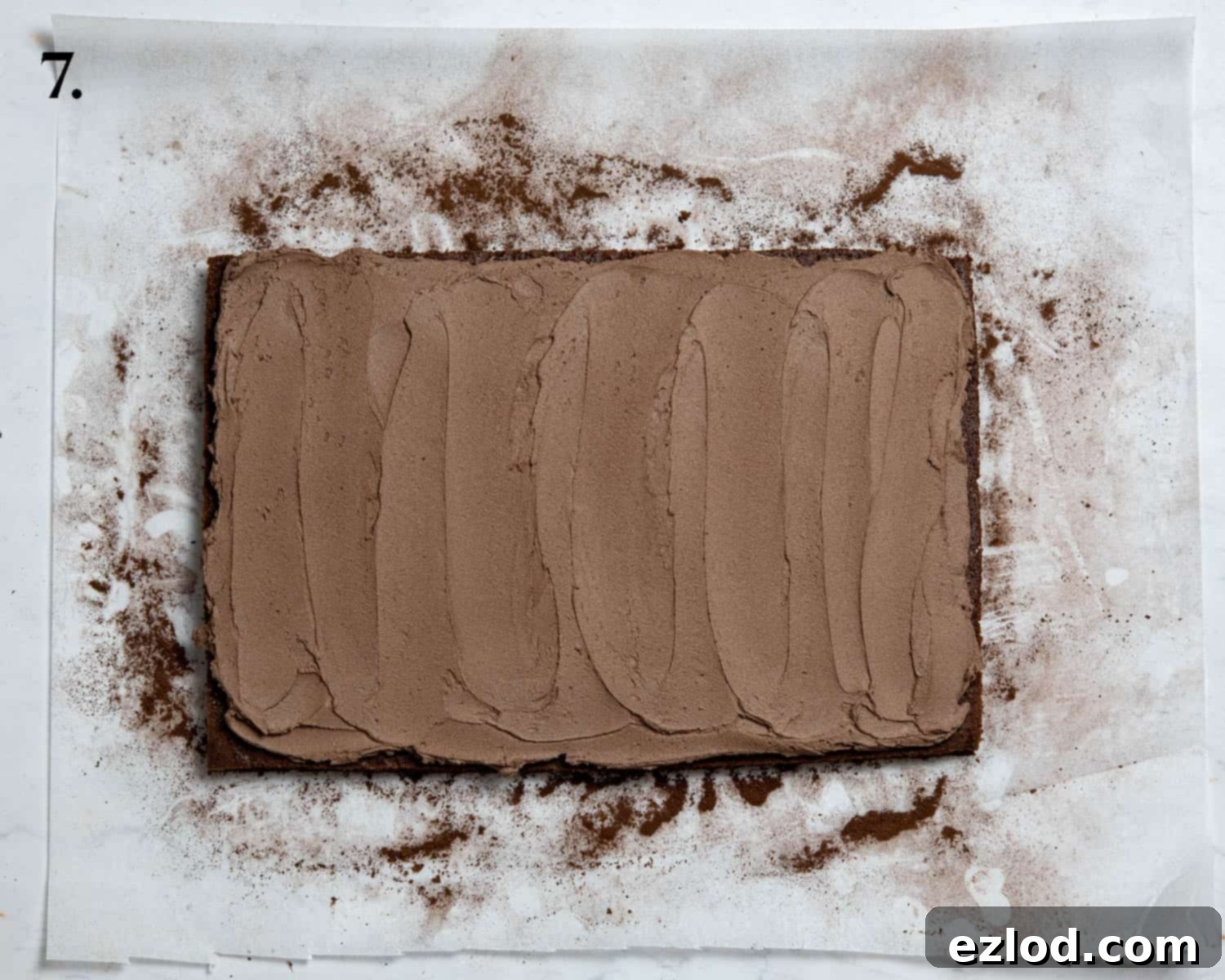
Step 8: Now for the crucial roll! Starting from one of the shorter edges, begin to roll the cake tightly into a spiral. Use the baking paper underneath to assist you in this process. Be confident and decisive – once you start rolling, try not to stop or unroll, as this can increase the chances of cracking. Once rolled, wrap the cake tightly within the baking paper and place it seam-side down in the refrigerator. Chill for at least 2 hours to allow the buttercream to set and the cake to hold its shape firmly. For best results, chilling overnight is highly recommended.
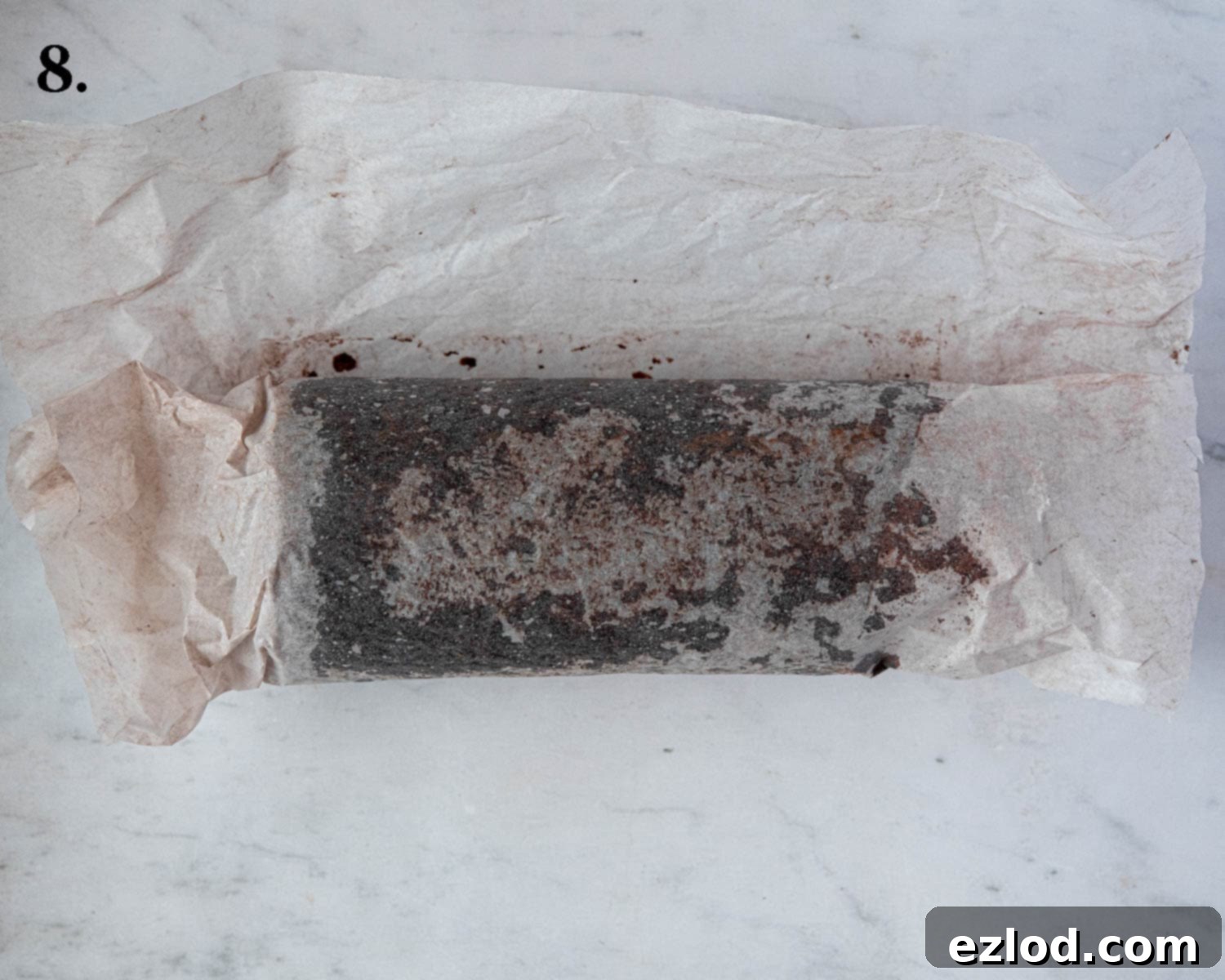
Step 9: Once thoroughly chilled, unwrap your yule log. To create the authentic log appearance, use a sharp serrated knife to slice off one end of the cake at an angle. Then, position this cut piece on the side of the main cake roll, securing it with a dab of ganache, to form a realistic “branch” effect.
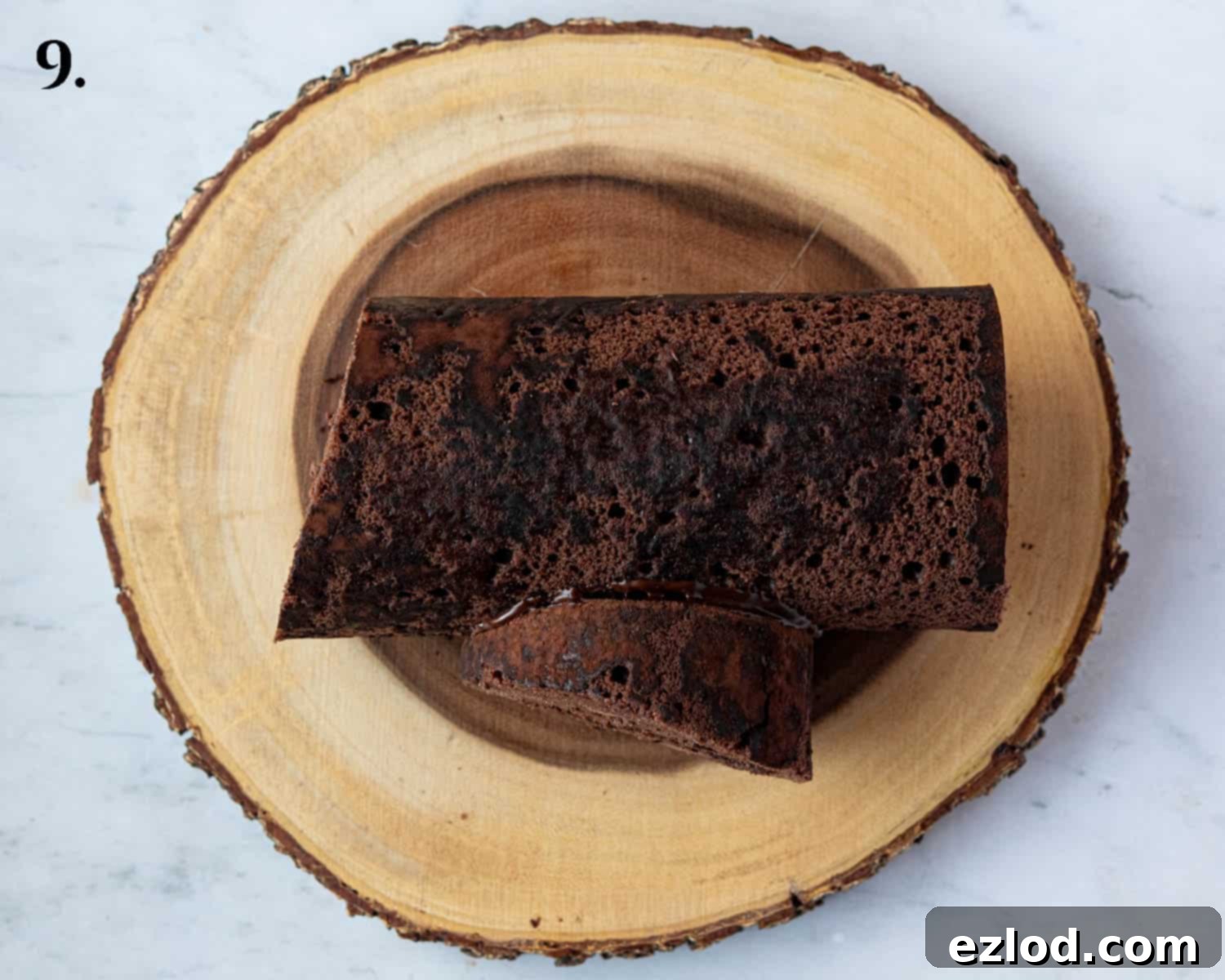
Step 10: Finally, it’s time to decorate! Use a palette knife to generously spread the cooled, thickened ganache over the entire surface of the cake, including the “branch” and the ends. To mimic the texture of tree bark, use the knife or a fork to gently score a realistic pattern along the top and sides of the log. Draw concentric rings on the cut ends to simulate tree rings. If your ganache becomes too firm during decoration, simply warm it gently over a pan of hot water until it softens to a spreadable consistency again.
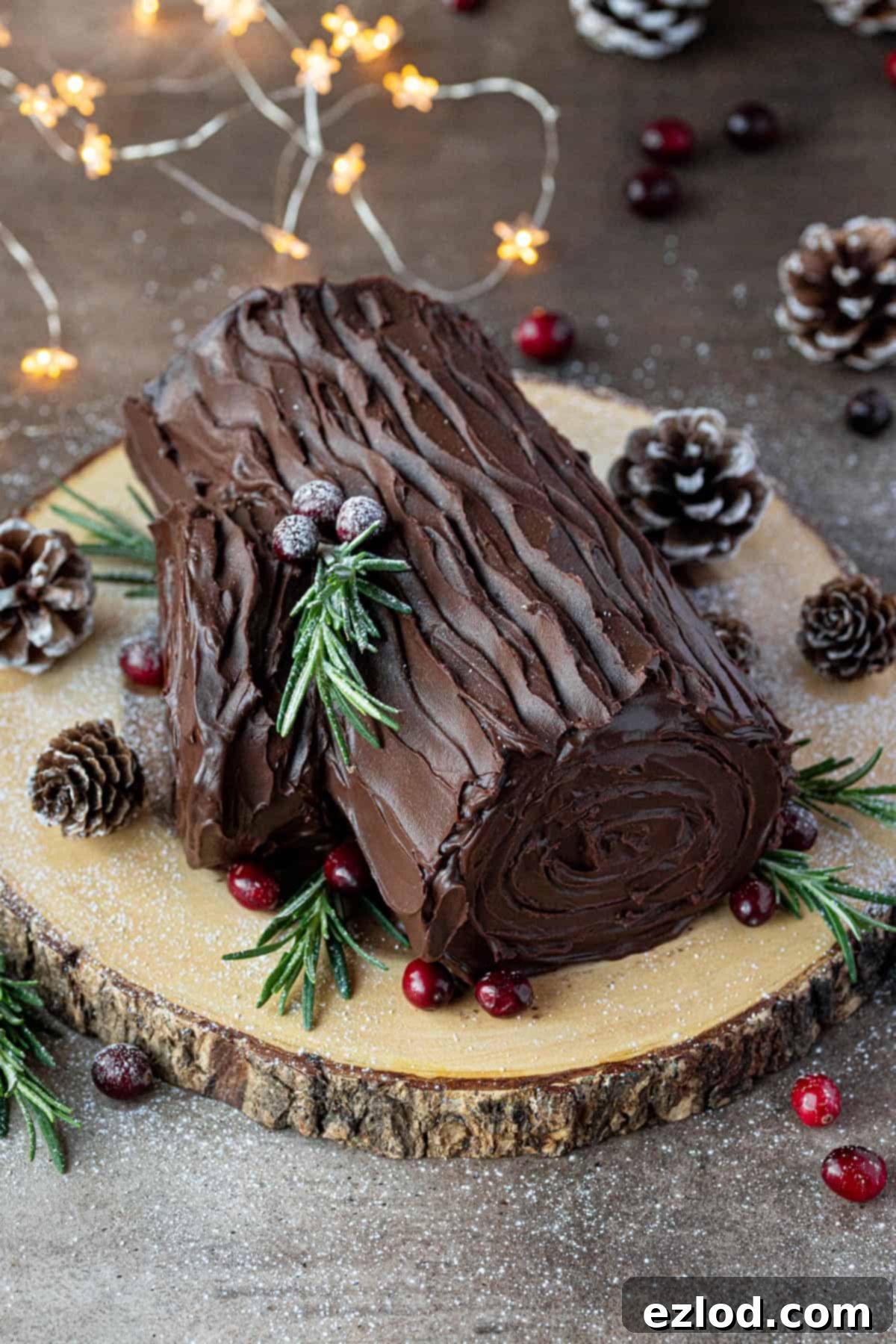
Expert Tips for a Flawless Vegan Yule Log
Achieving the perfect vegan chocolate yule log requires attention to detail. These expert tips will help you avoid common pitfalls and ensure a delicious, picture-perfect dessert:
- Embrace Digital Scales: For all baking endeavors, and especially for delicate recipes like this one, using metric measurements with a digital scale is paramount. Cup conversions are notoriously inaccurate and can lead to inconsistent results. A scale ensures precision, which is crucial for the delicate balance of ingredients in this cake. Plus, it’s often less messy and more efficient!
- Thorough Preparation is Key: Before you even start mixing, take the time to read through all the instructions carefully. Familiarize yourself with each step and review the accompanying step-by-step photos. This recipe requires precision and exact adherence to the instructions to guarantee success.
- Spotless Equipment for Aquafaba: Aquafaba is highly sensitive to grease and oil. Even a tiny hint of fat in your bowl or on your beaters can prevent it from whisking up properly, hindering its ability to create that crucial airy texture. To ensure perfection, wipe your bowl (preferably metal or ceramic, as plastic can retain oils) and beaters with a paper towel dipped in vinegar before you begin.
- Gentle Mixing Technique: Once your aquafaba is beautifully whipped, it’s vital to maintain as much of that precious air as possible. When incorporating the dry ingredients and later the remaining wet ingredients, use a light hand and a spatula to gently fold them in. Sifting your dry ingredients thoroughly beforehand will also help, as it eliminates lumps and reduces the need for aggressive mixing.
- Avoid Over-Baking at All Costs: This is one of the most critical steps. Over-baking the sponge will inevitably dry it out, making it much more susceptible to cracking when you attempt to roll it. Ovens vary, so keep a very close eye on your cake. It’s done when it’s set and a skewer comes out clean. If possible, use a standard non-fan oven for more predictable results.
- Roll with Confidence and Purpose: When it’s time to roll the cake, commit to it! Once you begin, be decisive and continue rolling smoothly and consistently. Stopping or attempting to unroll mid-way will significantly increase the chances of the cake cracking. Roll it tightly enough to create a good spiral, but gently enough not to squish the delicate sponge.
- Chill for Stability: After you’ve spread the buttercream filling and rolled the cake into its log shape, it is absolutely crucial to chill it properly. Wrap the rolled cake tightly in its baking paper and refrigerate it for a minimum of two hours. This chilling period allows the buttercream to firm up and helps the cake hold its spiral shape, making it much easier to handle and decorate. For optimal stability and flavor development, I often prepare this step the day before and refrigerate it overnight.
- No Substitutions Recommended: This vegan yule log recipe is incredibly delicate and has been carefully formulated to achieve the perfect balance of texture and flavor. Due to its precise nature, I strongly advise against making any substitutions for the ingredients listed. Any changes made are at your own risk and may impact the final outcome.
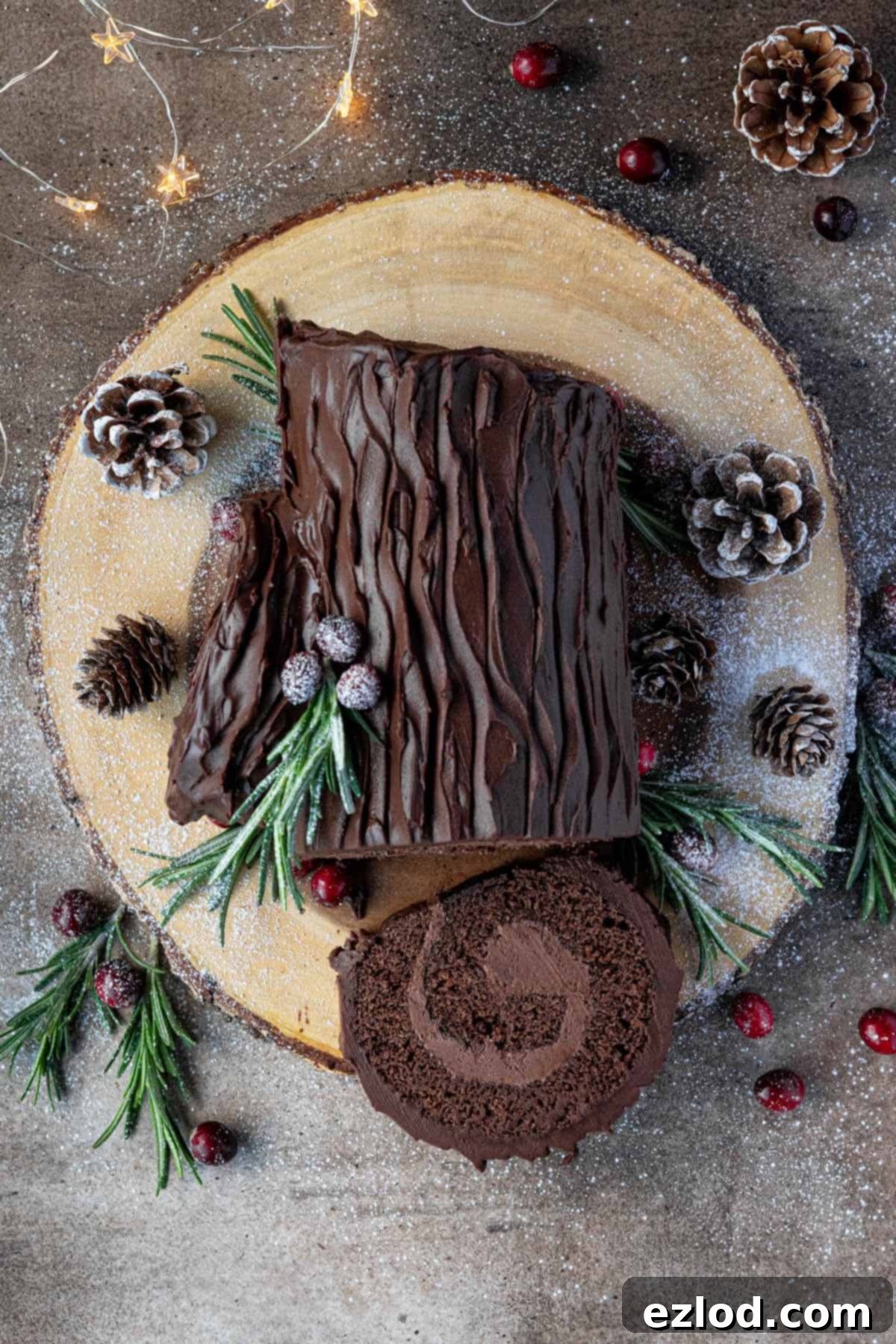
Frequently Asked Questions (FAQ’s)
The assembled yule log remains fresh for approximately 3 days when stored in an airtight container at cool room temperature. If your environment is particularly warm, it’s best to store it in the refrigerator and allow it to come to room temperature for about 30 minutes before serving to ensure the best texture and flavor.
Unfortunately, I do not recommend freezing this particular vegan yule log. The delicate sponge and filling may not maintain their optimal texture after thawing, potentially leading to a crumbly cake or a separated filling.
Yes, you can experiment with different fillings, but it’s important to choose one that is firm enough to spread without squeezing out during rolling, yet soft enough to provide a pleasant texture. If you opt for a whipped cream-style filling, ensure it’s stabilized and quite firm. Please note that if you use a cream-based filling, the cake will need to be stored in the refrigerator and its shelf life will be reduced to about a day or two.
More Festive Vegan Desserts to Enjoy
- Steamed Gingerbread Pudding
- Mincemeat Frangipane Tart
- Vegan Chocolate Christmas Pudding
- Chocolate Raspberry Mousse Cake
- Vegan Tiramisu
- Berry and Coconut Steamed Puddings
- Steamed Chocolate Pudding
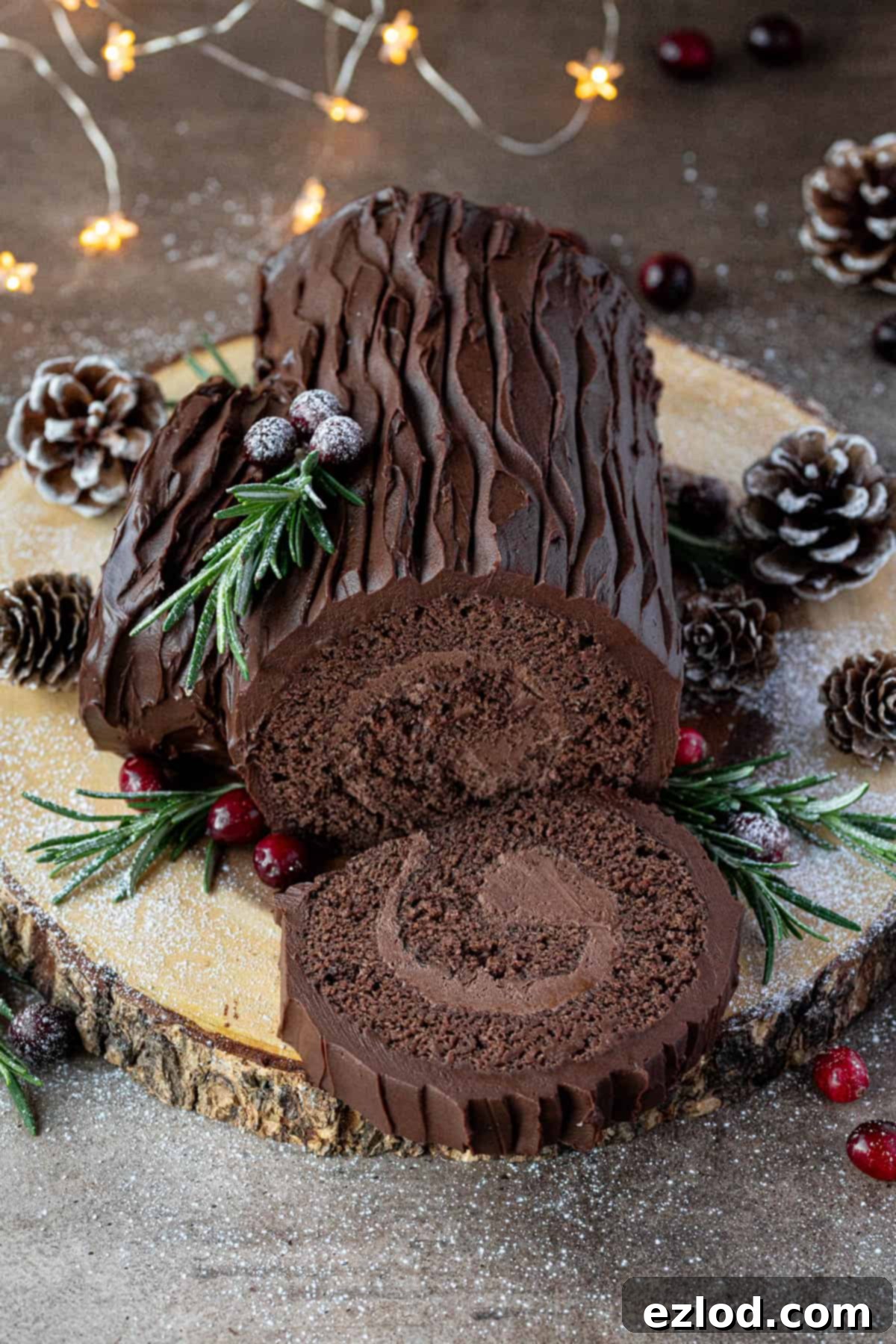
If you tried this delightful recipe, we’d love to hear from you! Please rate it, leave a comment below, or share your creation on Instagram by tagging @domestic_gothess and using the hashtag #domesticgothess.
All images and content on Domestic Gothess are protected by copyright. If you wish to share this recipe, kindly do so by utilizing the provided share buttons. Please refrain from screenshotting or posting the full recipe or content; instead, include a direct link back to this post for the recipe.

Print Recipe
Vegan Chocolate Yule Log Recipe
Ingredients
For the Cake:
- 120 g (½ cup) aquafaba
- ⅛ teaspoon cream of tartar
- 125 g (½ cup + 2 Tablespoons) caster (superfine) sugar
- 170 g (1 +⅓ cups) plain (all-purpose) flour
- 20 g (2 packed Tablespoons) cocoa powder
- 1 ¼ teaspoon baking powder
- pinch salt
- 80 g (⅓ cup) smooth applesauce*
- 41 g (3 Tablespoons) olive oil (or another neutral oil)
- 30 g (2 Tablespoons) unsweetened non-dairy milk (I use soy)
- 1 teaspoon vanilla extract
For the Buttercream:
- 100 g (3 ½ oz) vegan block butter softened
- 180 g (1 ½ cups) icing (powdered) sugar
- 25 g (2 ½ packed Tablespoons) cocoa powder
- 1 teaspoon vanilla extract
For the Ganache:
- 250 g (9 oz) dark chocolate finely chopped
- 200 ml (¾ cup + 1 Tablespoon) vegan double cream (I use Elmlea)**
Instructions
-
Preheat your oven to 200℃ (180℃ fan/400℉/gas mark 6). Line a Swiss roll tin, approximately 23 x 33 cm to 25 x 35 cm, with baking parchment, ensuring some overhang on each side for easy removal.
-
In a large, impeccably clean bowl, combine the aquafaba and cream of tartar. Beat with an electric mixer until the mixture turns white and frothy. Gradually whisk in the sugar, a spoonful at a time, ensuring each addition is well incorporated before adding the next. Continue whisking until the aquafaba achieves a consistency similar to softly whipped cream – it should be glossy and hold trails from the beaters, but not yet form firm peaks.
-
In a separate bowl, mix together the plain flour, cocoa powder, baking powder, and salt. Sift this dry mixture over the whipped aquafaba. Gently fold the dry ingredients into the aquafaba using a spatula until they are about halfway combined, taking care to preserve the air in the mixture.
-
Now, add the applesauce, oil, milk, and vanilla extract. Continue to gently fold until no dry lumps remain and the batter is smooth. The mixture will deflate somewhat, but try to retain as much air as possible.
-
Pour the batter into the prepared tin and spread it evenly. Bake for 8-11 minutes, or until the cake is set and a skewer inserted into the center comes out clean. It’s crucial not to overbake, as this will dry out the cake and make it prone to cracking. Monitor closely as oven times can vary.
-
While the cake is baking, cut a rectangle of baking paper slightly larger than your cake. Lightly dust this paper with a thin, even layer of cocoa powder – do not use too much.
-
Once baked, carefully flip the hot cake out, top-side down, onto the cocoa-dusted parchment. Do not remove the original parchment from the underside of the cake. Allow it to cool completely between the two sheets of parchment for about 1 hour. This method helps keep the cake moist and pliable.
-
While the cake is cooling, prepare the buttercream. Place the softened vegan block butter in a large bowl and whisk until smooth and creamy. Sift in the icing sugar and cocoa powder, then add the vanilla extract. Continue to whisk for several minutes until the buttercream is light, fluffy, and well combined.
-
After the cake has fully cooled, gently peel off the top sheet of baking paper. Using a sharp serrated knife, trim off the drier edges of the cake; these tend to be less flexible and more prone to cracking during rolling.
-
Using a palette knife or offset spatula, spread the prepared buttercream evenly over the entire surface of the cake, leaving a small border at the edges.
-
Starting from one of the shorter edges, tightly roll the cake into a spiral. Use the baking paper underneath to aid in the rolling process, being decisive and continuous once you begin. Roll the cake tightly inside the paper and place it seam-side down in the fridge to chill for a minimum of 2 hours. Chilling it overnight is ideal for a firm set.
-
To make the ganache, place the finely chopped dark chocolate and vegan cream (or milk and butter mixture) in a heatproof bowl. Set this bowl over a pan of gently simmering water, ensuring the base of the bowl does not touch the water. Stir continuously until the chocolate is completely melted and the mixture is smooth and glossy. Remove from the heat.
-
Set the ganache aside to cool. It needs to thicken enough to be spreadable, which typically takes 1-2 hours at room temperature, or less if chilled slightly. Stir occasionally to prevent a skin from forming.
-
Once the ganache is nearing a spreadable consistency, unwrap the chilled yule log. Using a sharp serrated knife, slice off one end of the cake at an angle to create a natural “branch” effect. Carefully transfer the main log to your serving platter. Use a small amount of the ganache to adhere the angled slice to the side of the main cake roll, forming a realistic branch.
-
Use a palette knife or offset spatula to spread the ganache generously over the entire cake, including the top, sides, and the ends of both the main log and the “branch.” To create the look of tree bark, use the edge of your knife or the tines of a fork to gently score a textured pattern along the ganache. Draw rings on the ends of the log to mimic tree rings. If the ganache becomes too firm to spread during this process, simply place the bowl back over hot water and stir until it softens again.
-
For a beautiful festive touch, decorate your finished yule log with fresh cranberries and sprigs of rosemary, if desired. Store the cake in an airtight container at a cool room temperature until ready to serve.
Notes
- *If you’re using unsweetened apple sauce, that’s ideal. If not, you can easily make your own (many recipes are available online). Alternatively, if using jarred apple sauce typically served with pork, ensure to press it through a fine mesh sieve with the back of a spoon to remove any apple chunks before use.
- **For the ganache, an alternative to vegan double cream is a mixture of 150ml unsweetened soy milk plus 50g vegan block butter.
- Precise Measurements with Scales: For optimal baking results, I strongly recommend using metric measurements with a digital kitchen scale instead of cup conversions. Cup measurements can be highly inaccurate, and using a scale will lead to much more consistent and superior outcomes, often with less mess.
- For more detailed tips, ingredient insights, and step-by-step photos, please refer to the main article above the recipe card.
- This is a very precise and delicate recipe. I cannot guarantee results for any ingredient substitutions not explicitly mentioned. Any alterations are made at your own discretion and risk.
